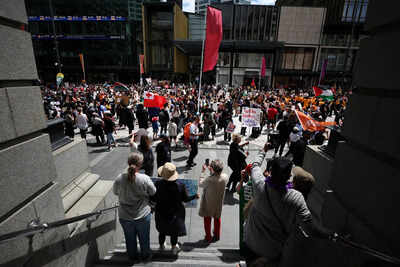New Zealand mega strike: Why are teachers walking out of classrooms?

More than 60,000 school teachers across New Zealand joined nurses, doctors and public-service staff on 23 October 2025 in what is described as a ‘mega strike’, reports The Guardian. The walkout, which also involved 40,000 nurses and 15,000 public-service employees, reflected the growing frustration of teachers who say their pay packets and working conditions have failed to keep pace with inflation, housing costs and classroom demands.
New Zealand government’s offer to the teachers
According to New Zealand’s Ministry of Education’s collective-bargaining summary (updated 19 September 2025), the government’s second offer to secondary teachers was tabled on 5 September and rejected on 12 September 2025 after ten days of negotiations. The proposal included a 1 per cent annual pay rise spread over three years, an increase that the Post-Primary Teachers’ Association (PPTA) described as “well below inflation” and “disrespectful to the profession.”New Zealand media houses corroborate that both the PPTA and the New Zealand Educational Institute (NZEI) turned down similar offers for the area-school teachers, and primary-school teachers rejected a 2.7 per cent offer on similar grounds. Union leaders argue that these packages fail to address workloads, large class sizes and retention challenges. The government, however, maintains that fiscal limits constrain any higher offer.
How much do New Zealand’s teachers actually earn?
An October 2025 analysis by Radio New Zealand (RNZ) breaks down the country’s teacher salaries using official Ministry of Education data. RNZ notes that the base pay scale for trained teachers in state and state-integrated schools starts at NZ $61,239 per year (≈ NZ $5,100 a month) for new entrants and tops out at NZ $103,086 per year (≈ NZ $8,590 a month) at Step 10.Complementing those step figures, the Ministry’s Teacher and Principal Workforce Report (April 2025) lists the average annual remuneration in 2024—including allowances but excluding KiwiSaver/superannuation—as NZ $94,354 for primary, NZ $100,933 for secondary, and NZ $99,155 for area-school teachers.Union representatives contend that those averages hide the gap between seasoned teachers with multiple management units and newcomers still paying off training loans. As one Auckland-based teacher told RNZ, “It looks like we’re well-paid on paper, but when you factor in housing, workload and unpaid hours, it doesn’t feel like a six-figure job.”
What else do teachers want besides higher pay?
While compensation is a central issue, the reason large numbers of teachers in New Zealand are striking goes well beyond base salaries. According to a media release by the PPTA Te Wehengarua on 11 October 2025, the action was triggered after the Government’s offer “fails to address the issues that are at the heart of our claims”. These include increasing teacher shortages, “thousands of students being taught by teachers who are not subject specialists”, and the need for “more pastoral staffing to support the increasing number of students struggling with learning”.Similarly, a release from the primary‐and‐area‐school union NZEI Te Riu Roa notes that area-school teachers want “secure work and pay that addresses increases in the costs of living”, and “more support for children in the classroom”.Put together, the non-pay demands of teachers centre on four core themes:
- Staffing and workload: Teachers are working in understaffed schools, asked to cover classes outside their subject expertise, often leading to burnout and attrition.
- Support for students: There is a growing call for increased pastoral and specialist support (for mental health, additional learning needs, te reo Māori integration) so that teachers can focus on teaching rather than administrative overload.
- Retention and recruitment: With many teachers leaving the profession for better conditions overseas (especially Australia), unions say offers must create a sustainable teaching workforce—not just reward those already in it.
- Funding and conditions: The strike is also about the broader funding of public education—teachers argue that pay offers alone won’t suffice unless schools are equipped with enough staff, resources and manageable workloads.
The larger picture
The “mega strike” underscores a widening rift between New Zealand’s educators and its government. For teachers, this is no longer a narrow pay dispute—it’s a campaign to restore dignity and sustainability to the profession. For policymakers, it’s a balancing act between economic restraint and a public-sector workforce that’s running out of patience.






